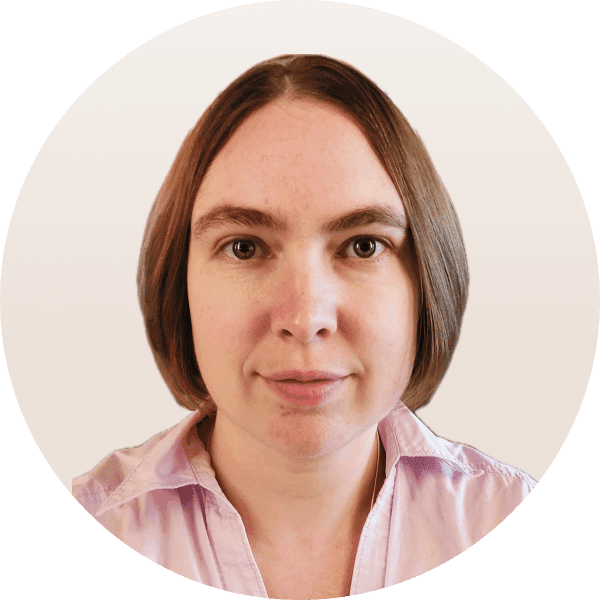An ecommerce online marketplace is a digital platform connecting multiple third-party sellers with potential buyers, facilitating the buying/selling of a wide range of products or services. These marketplaces serve as intermediaries, allowing various independent sellers or businesses to list and sell their products or services to a larger audience of online shoppers.
While there are many ecommerce online marketplaces, only a few cater to sellers looking to sell handmade and one-of-a-kind products. Etsy is one of the most fascinating examples of a global handicraft business creation.
For 20 years, Etsy has been a platform to sell products like sculptures and handwritten recipes. In general, it is an ecommerce website that focuses on selling handmade or vintage goods from individuals.
In this article, we will determine how to create a website like Etsy. You will learn how this two-sided ecommerce online marketplace works and how it makes money. Moreover, you will find out how much it costs to create a platform similar to Etsy and which core features it should have.
Etsy: an overview of the global online marketplace
The Etsy project was started in 2005. Today, it is a vast online marketplace development solution with around 8 million active sellers and over 100 million products. The site allows sellers to equip their own "shops" and sell directly.
What can buyers look for on Etsy's website? Everything! It is about unique designer things, creative gifts, vintage items that customers will find all here.
Etsy: how it started
The idea of the ecommerce marketplace solution launching belongs to the artist and photographer Rob Kalin. In general, Kalin says the idea of developing the Etsy online marketplace came to his mind when he realized there was no appropriate site for selling handmade goods.
The businessman's partners were his two friends, Chris Maguire and Haim Schoppik. The originality of the idea and the presence of a free niche led the friends to undertake the project. None of them was an expert in web development, but everyone was fond of creativity and wanted to improve the world.
Three months later, a platform prototype received the name Etsy and was ready. Kalin said the online marketplace received such a name because it sounds excellent, and it is convenient to build a brand with unique features around such an original word. Interestingly, “Etsy” comes from the Italian “eh, si,” meaning “oh, yes.”
To attract the initial audience and solve the chicken-and-egg problem, Etsy representatives began to regularly visit various arts and crafts exhibitions in the US and Canada. At that time, the anti-consumer movement was gaining popularity. So, the number of various fairs where you could buy or sell handmade things grew by leaps and bounds.
Gradually, the service increased the target audience and attracted sellers significantly. In July 2007, the millionth sale was made on the Etsy handmade marketplace. And in November of the same year, more than 300,000 purchases worth over $4.3 million were made on the marketplace.
The high growth rate of the service's audience soon attracted the attention of venture capital funds. So, in January 2008, Etsy received a $27 million investment.
Nowadays, Etsy is a super-successful ecommerce company, and many wonder how to create an online marketplace like Etsy. Let’s see what makes Etsy special and what you need to build a similar website.
Key Etsy facts
If you are wondering how to create a website like Etsy, let's quickly look at the key Etsy facts.
- Founder: Rob Kalin, Haim Schoppik, Chris Maguire, and Jared Tarbell
- Year founded: 2005
- Funding received: a total of $98 million in 14 rounds
- Number of buyers: around 95 million active buyers
- Number of sellers: around 8 million active sellers
- Number of employees: 2400 employees (as of December 2024)
- Etsy’s competitors: Amazon Handmade, eBay, Aftcra, Ruby Lane
Etsy’s payment gateways
There are dozens of gateway providers. However, the Etsy marketplace cooperates with such licensed providers as:
- PayPal
- Apple Pay
- Google Pay
- Klarna
- iDEAL
Besides, users of the Etsy marketplace can choose between multiple payment methods and pay by credit cards, debit cards, bank cards, Etsy Gift Card, Etsy Credits, etc.
Read also: 11 Best Payment Solutions for Online Marketplaces in 2025
Etsy's marketplace battles
In this ever-evolving ecommerce landscape, Etsy doesn't stand alone. To gain a comprehensive perspective on its competitive surroundings, let's delve into the world of its analogs, challengers, and like-minded platforms.
eBay
A household name in ecommerce, eBay predates Etsy and offers a broad range of products. It's a diverse marketplace where new and used items are bought and sold, catering to various consumer preferences.
Amazon
A global giant, Amazon, extended its reach to the handmade niche with Amazon Handmade. While it competes with Etsy in some areas, it offers different features and a vast customer base.
eCrater
It offers a free online marketplace platform where sellers can list products and have them integrated into a standalone online store. It's a budget-friendly choice for small businesses and amateurs.
Comparing the key elements: what sets them apart
Now, it is crucial to understand the unique features and offerings of these prominent platforms.
| Aspect | Etsy | eBay | Amazon Handmade | eCrater |
| Product categories | Handmade, vintage, unique items | New and used items in various categories | Handmade and artisanal products with Amazon's customer base | Platform for listing products and integrating into standalone online stores |
| Community and support | Supportive seller community | Offers support in community and staff discussions | Benefits from Amazon's solid customer base | Provides budget-friendly options for creating online stores |
| Listing fees & pricing | Listing fees and transaction fees | Listing fees and final value fees upon sale | Referral fee structure based on item category | No listing or transaction fees |
| Reach & global presence | Global presence, connecting buyers and sellers worldwide | International reach and recognition | Leverages Amazon's extensive reach | Online marketplace open to many sellers and buyers |
So, each platform has its unique value proposition, serving the diverse needs of creators, collectors, and shoppers. The world of ecommerce analogs to Etsy has something for everyone. The choices are great, and the fierce competition drives innovation and diversity in the online marketplace.
Read also: An Online Marketplace Marketing Strategy That Works in 2025
Monetization strategies for platforms like Etsy
Etsy's business model is similar to other online marketplaces like eBay and Amazon. It is a two-sided P2P (peer-to-peer) marketplace for selling and buying precise, unique, and creative items.
What sets Etsy apart from the rest of the platforms? It is the vertical approach to Etsy’s business model. In general, the marketplace focuses on selling crafts in particular categories. For example, these can be unique handcrafted items or vintage treasures. To compare, Amazon-like sites have a horizontal business model where almost everything is for sale.
Etsy does not charge buyers fees for using the platform. Buyers can browse and shop on Etsy without incurring additional charges beyond the purchase price of their chosen items. Etsy's monetization strategies are focused on the seller side of the platform, allowing sellers to list and sell their products while Etsy collects fees based on their sales and services.
Now, let's discuss details of how you can monetize the marketplace similar to Etsy and how this P2P platform does it.
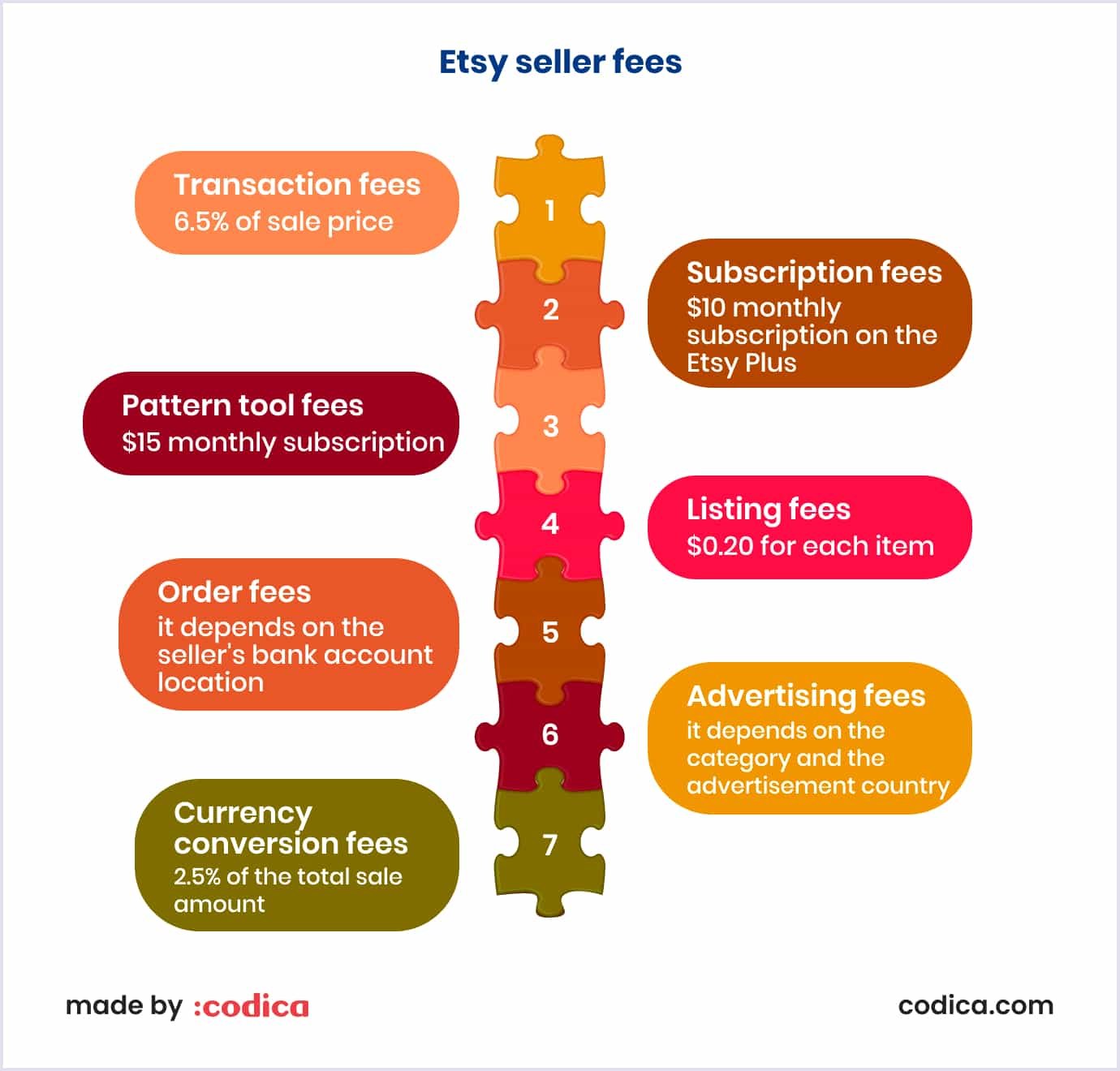
Transaction fees
One of the fundamental ways Etsy generates revenue is through transaction fees. When a seller successfully sells on Etsy, the platform charges a transaction fee. Etsy charges sellers a transaction fee of 6.5% of the price for every prosperous sale through its platform. This fee structure ensures that Etsy benefits directly from the wins of its sellers. It's a win-win approach that aligns the interests of both the platform and its sellers.
Subscription fees
Subscription-based models are a common monetization method for online marketplaces. Often, sellers on websites like Etsy.com can sign up for a package that offers multiple additional tools to boost sales. These can be advanced shop customization or access to discounts. For example, the Etsy marketplace charges a monthly subscription on the Etsy Plus package fee of $10. This subscription model provides sellers with additional resources to grow their businesses while creating a steady source of monthly revenue for Etsy.
Pattern tool fees
Pattern is a website builder tool by the Etsy marketplace intended for its sellers. It enables merchants to build online shops on domains independent of Etsy’s platform. The first thirty days of Pattern’s use are free. Then, Etsy charges a monthly subscription fee of $15. This tool fee provides sellers with a valuable service and contributes to Etsy's monetization efforts.
Listing fees
Another way Etsy generates revenue is through listing fees. Etsy charges vendors at least $0.20 for each item they list on the platform. Nevertheless, that’s a profitable revenue model for a marketplace like Etsy. Why? While this fee may seem minor, it becomes a profitable revenue source for Etsy due to the volume of products listed daily on the platform. With thousands of unique and handcrafted items listed regularly, the cumulative effect of these listing fees is substantial.
Order fees
Also, Etsy monetizes its marketplace through charges via the processing of payments. The total fee amount per order varies depending on the seller's bank account location. While the exact fee structure may differ, it represents an additional source of income for Etsy. Payment processing fees ensure secure and reliable transactions for buyers and sellers.
Advertising fees
Usually, online shops like Etsy offer various promotional services to help their vendors increase sales. The advertisements are charged through a cost-per-click (CPC) approach. Notably, CPC rates differ depending on the category and the advertisement country, ensuring that Etsy optimizes its advertising revenue while assisting sellers in reaching their target audience.
Currency conversion fees
It is also a popular revenue model for websites similar to Etsy, especially when dealing with international transactions. For instance, when converting the currency, Etsy charges 2.5 percent of the total sale amount. This fee ensures Etsy maintains favorable exchange rates while generating additional revenue from cross-border sales.
So, we have discussed what types of monetization strategies websites like Etsy can use. Etsy, a popular marketplace for unique and handcrafted goods, employs various monetization techniques to generate revenue while offering a platform for creative entrepreneurs. However, depending on the niche, there can be other methods of fee-charging.

Features of P2P (peer-to-peer) marketplace like Etsy
The renowned online marketplace for handmade and unique products - Etsy - has become a global idol of independent entrepreneurship and artisanal craftsmanship. Its success is not solely attributed to its vast and diverse product offerings but also to the carefully curated and thoughtfully designed core ecommerce features that support its user-friendly interface.
So, let's uncover what has made Etsy a household name in the world of ecommerce in terms of the following features.
Etsy’s features for buyers

Product listings and details
- Rich product descriptions: sellers can create detailed listings, including high-quality images, product descriptions, pricing, and product attributes. The freedom to provide extensive details allows buyers to make informed choices.
- Variations: for items with multiple options (e.g., sizes or colors), sellers can create variations within a single listing, simplifying the shopping experience.
- Customization options: some listings offer customization, allowing buyers to personalize their purchases according to their preferences.
Product categories
- Structured organization: products are categorized into various sections and categories, making it easy for buyers to navigate and discover items of interest.
- Search filters: buyers can filter search results by price, location, and item specifics, streamlining the product discovery process. Moreover, Etsy uses machine learning (ML) technology to find relevant items even when a buyer is not sure about the product’s name.
AI-powered product recommendations
As part of their technology strategy, Etsy leverages the power of AI and ML to help buyers find products they have not searched for, but may find interesting. Moreover, Etsy has introduced the Gift Mode feature for discovering personalized gift ideas.
User reviews and ratings
- Transparent feedback: users can leave reviews and rate products and sellers, enhancing transparency and trust.
Conversations and messaging
- Direct communication: buyers and sellers can directly message each other to discuss orders, ask questions, and clarify details.
- Order updates: sellers can inform buyers of order updates and shipping information through the messaging system.
Shopping cart and checkout
- Cart management: buyers can add items to their shopping carts and proceed to checkout seamlessly.
- Payment options: Etsy integrates with various payment gateways, ensuring secure transactions. This includes credit cards, PayPal, and Etsy's payment system.
Mobile responsiveness
- Optimized mobile experience: Etsy offers a responsive design, providing a seamless shopping experience on mobile devices, which is crucial in an era of mobile ecommerce.
Social sharing and integration
- Social media sharing: products, shops, and favorites can be shared on social media platforms, boosting exposure.
Etsy’s features for sellers
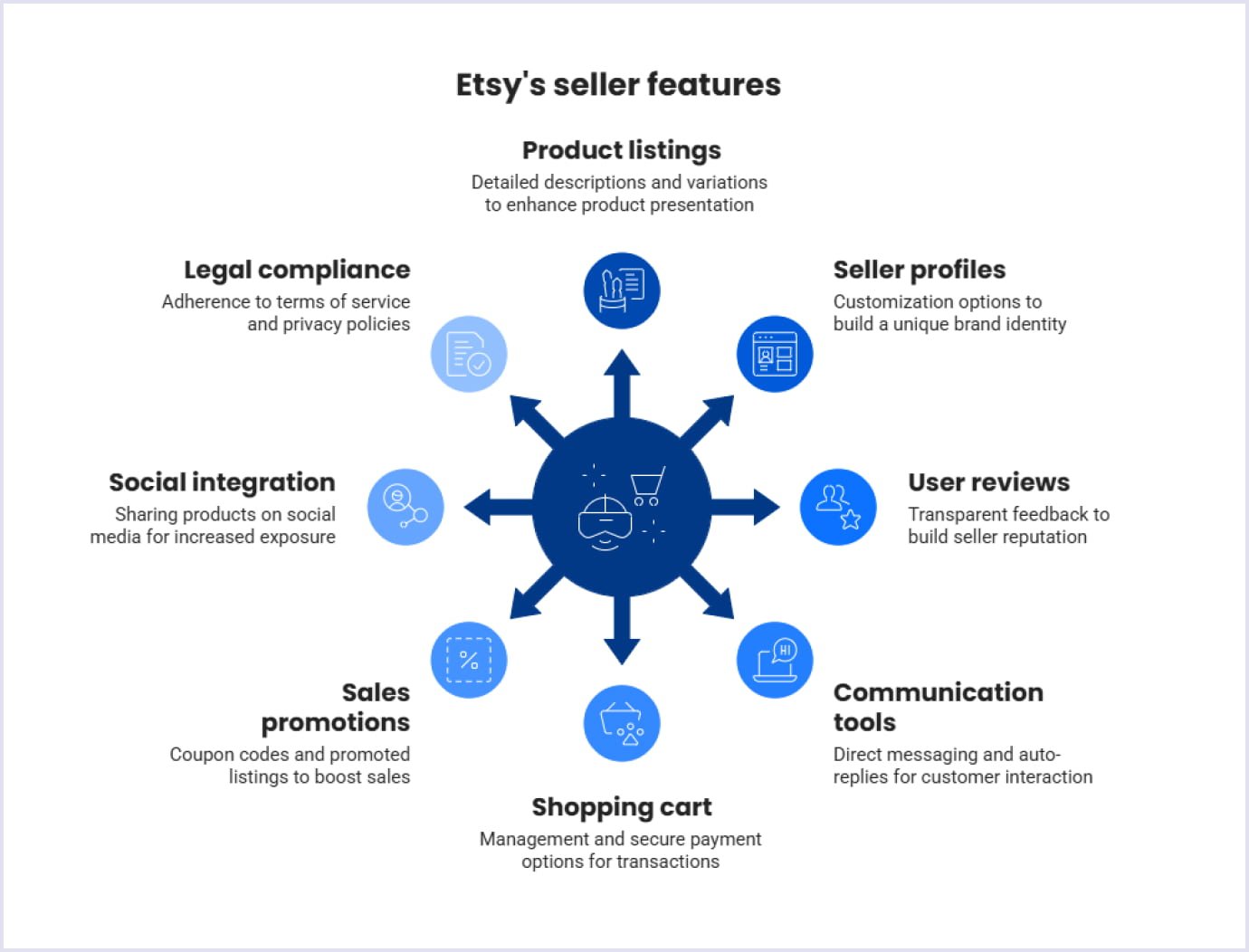
Product listings and details
- Detailed product descriptions: sellers can create detailed listings, including high-quality images, product descriptions, pricing, and product attributes.
- Variations: sellers can create variations for items with multiple options to simplify the shopping experience.
- Customization options: some listings offer customization, allowing sellers to offer personalized products.
Seller profiles
- Shop customization: sellers can customize their shop profiles with banners, logos, and a distinct brand identity.
- Seller information: seller profiles provide information about the creator, their inspiration, and shop policies, adding a personal touch to the shopping experience.
User reviews and ratings
- Transparent feedback: sellers receive reviews and ratings from customers, contributing to their reputation in the marketplace.
Conversations and messaging
- Direct communication: sellers can communicate directly with buyers to discuss orders, answer questions, and provide order updates.
- Auto-reply: when a seller needs a vacation, their store still works with the auto-reply feature that provides basic information to customers while the seller is unavailable.
- Thank-you messages: this feature not only enhances the buyer experience but also helps sellers to build connections with their customers and encourage repeat business.
Shopping cart and checkout
- Cart management: sellers can manage and process orders from the shopping cart.
- Payment options: sellers can use Etsy's integrated payment system, along with options like credit cards and PayPal, for secure transactions.
Sales and promotions
- Coupon codes: sellers can create coupon codes to offer discounts to customers, encouraging repeat purchases.
- Promoted listings: sellers can pay to have their products featured prominently in search results and category pages to enhance visibility.
- Bulk listing management: sellers can manage their listings in bulk, which is helpful to handle similar listings or products during holiday spikes.
Social sharing and integration
- Social media sharing: sellers can share their products and shops on social media platforms for increased exposure.
- Integration with Facebook and Pinterest: Etsy integrates with Facebook and Pinterest for streamlined sharing and marketing.
Legal and compliance
- Terms of service: sellers must adhere to Etsy's terms of service, ensuring legal compliance.
- Privacy policies: Etsy's privacy policies explain how user data is collected, used, and protected, helping sellers maintain user trust.
Etsy's fundamental features have been meticulously designed and continuously refined to create a unique, user-centric ecommerce platform that offers a delightful shopping experience to buyers. With these basic features, Etsy has fostered a successful community and set a high standard for P2P marketplaces. Whether you want to build your marketplace, these essential features provide a blueprint for creating a vibrant and user-friendly ecommerce ecosystem.
You may also like: What is a P2P marketplace? Key steps for building P2P marketplace software
Selecting the right tech stack for building an online marketplace like Etsy
Notably, choosing the technology stack can affect the development budget, time, web application quality, and scalability of your own marketplace. To build a scalable, secure, and reliable platform like Etsy, we recommend you to use the right technology stack.
Let's take a look at the two main parts of the Etsy tech stack: frontend (client-side) and backend (server-side). Each of the two parts implements specific functions and comprises a relevant set of tools.
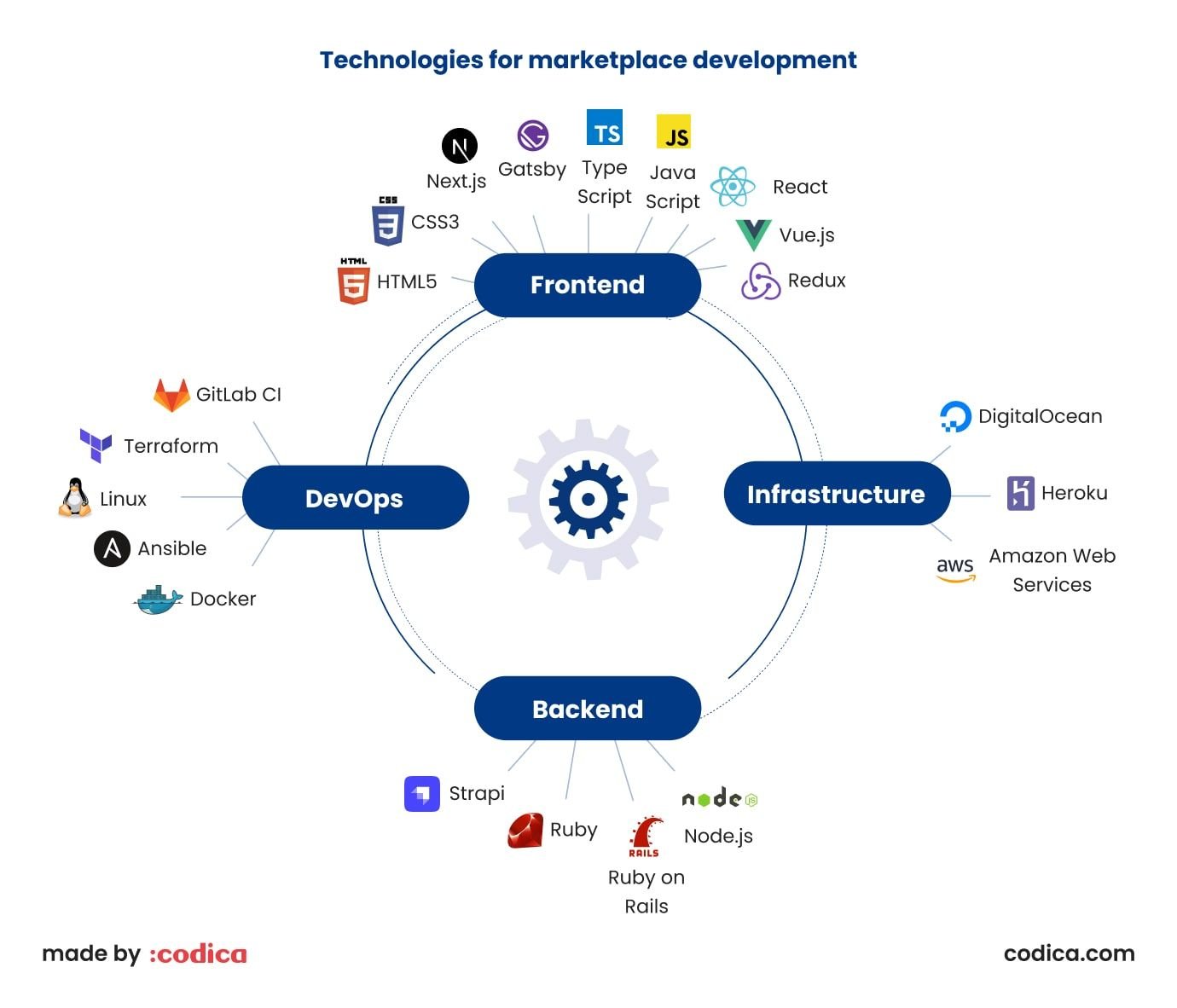
Frontend or client-side
React is the choice of the Etsy marketplace for its client-side. Nevertheless, you can choose any other technology stack for your website development. At Codica, we prefer React, JavaScript, Vue.js, Gatsby, and HTML5 for building web projects.
Backend or server-side
As for the server-side, Etsy uses Python and Java programming languages. Also, you can choose Ruby on Rails and Ruby for the Etsy-like marketplace development.
Third-party tools and integrations
There are utilities that Etsy uses, such as Google Analytics, AfterShip, AppThwack.
Moreover, it uses such apps as Apache HTTP Server, Amazon S3, Amazon EC2, Amazon CloudFront, Amazon EBS, Amazon EMR, and business tool G Suite.
Selecting the advanced tech stack for your marketplace, like Etsy, is a critical decision that can significantly impact your platform's performance, scalability, and overall success. Carefully assess your project's requirements, your team's expertise, and the specific needs of your marketplace to make informed choices at each stage of development.
Step-by-step guide to creating P2P ecommerce websites similar to Etsy
Building a peer-to-peer ecommerce Etsy-like site is a challenging yet rewarding experience. Success will depend on your ability to create a supportive community, provide a platform that's easy to use, and continually adapt to the evolving needs of your users. Now, let’s see what aspects you must consider when building a marketplace like Etsy.
Step 1. Product discovery with comprehensive tech and business analysis
Any great idea for becoming a successful online marketplace requires careful planning. That is why, at Codica, we start any project with product discovery sessions. During these sessions, we review your documentation and requirements and perform a thorough analysis to understand your business idea and goals. If you want to learn how to create an online marketplace like Etsy to achieve success, we recommend starting with product discovery.
The project discovery stage is the foundation for vital insights to develop Etsy’s clone. For instance, we provide you with specific deliverables, such as clickable prototypes, feature list, specification, time and cost estimates, and recommendations on team composition.
Check out the video below to understand in more detail what you get after our product discovery sessions.
Step 2. UI/UX design that works
To create the right design for your marketplace software, similar to Etsy's website design, it is important to look at your site from the users’ point of view. We will attempt to answer the question of how to create a website like Etsy and share some guidelines that help you make an excellent user experience (UX) for a platform featuring handmade goods.
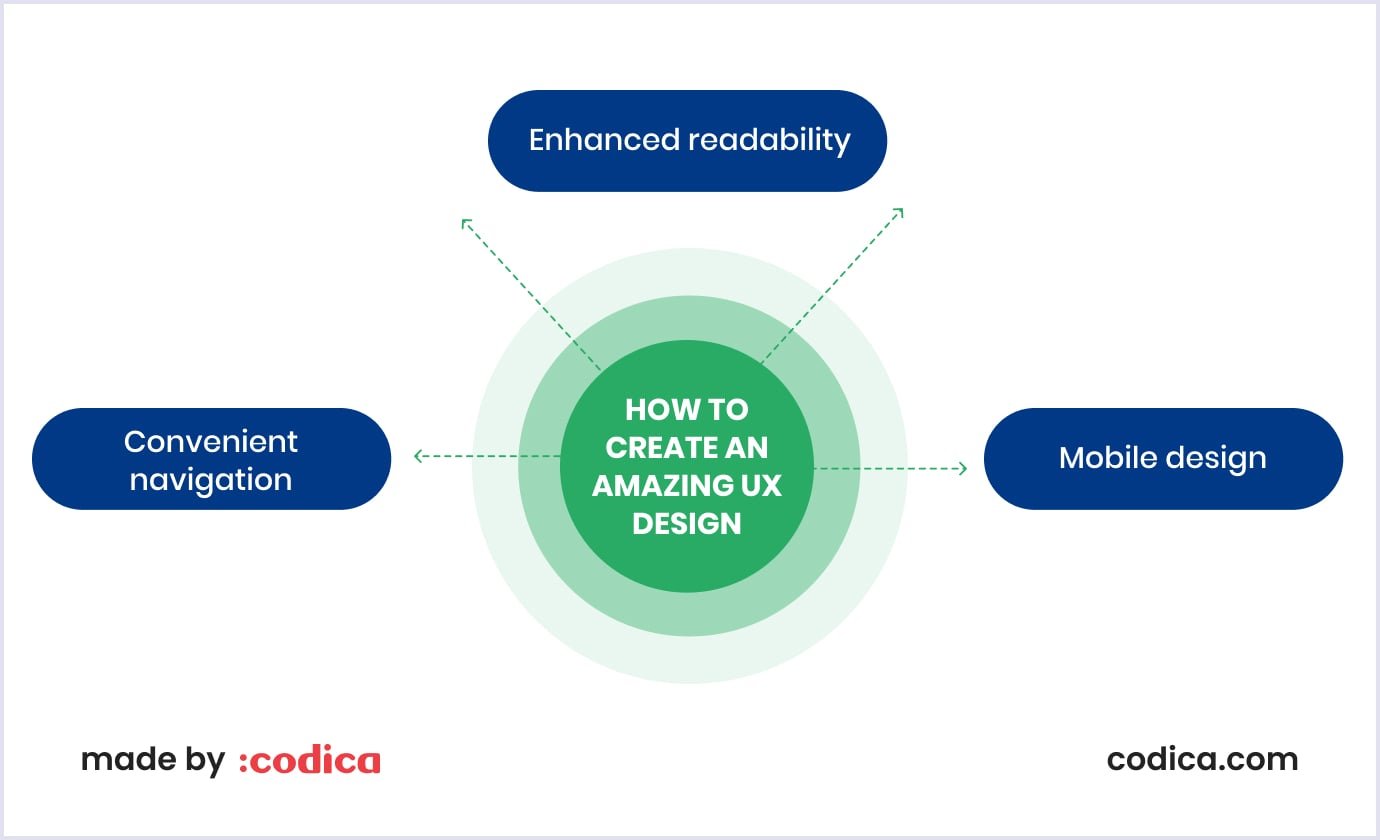
Convenient navigation. Your site’s interface should be understandable and straightforward, just like Etsy's website design. Furthermore, sellers and buyers should reach their goals with a minimum number of actions. It is crucial to develop the app’s blueprint in a way that makes it clear to users and reduces their operational actions. Certainly, the best approach is to hire a qualified UI/UX design services company to design a marketplace like Etsy.
Enhanced readability. We recommend using one font in the design, with a maximum of two: one for headers and one for the text. Also, make the font size comfortable for reading.
Mobile design. Therefore, it is essential to understand that modern businesses require an adaptive design for tablets and mobile devices. It is a must-have because people have been using mobile devices for a long time.
At Codica, we offer cross-platform mobile app development services tailored to our customers' needs.
Etsy, a leading online marketplace, is developed using React Native, and this choice carries several advantages that make it a recommended platform for building cross-platform applications.
React Native, as used by Etsy and many other prominent brands, offers the following benefits:
- Code reusability: React Native allows developers to write code once and deploy it across multiple platforms, such as iOS and Android. This results in significant time and cost savings compared to building separate native apps.
- Faster development: Using a single codebase for both platforms accelerates the development process. Updates and feature additions can be implemented more swiftly, reducing time-to-market.
- Native performance: React Native provides near-native performance, as it compiles to native code. This means your application will have a responsive and smooth user experience.
- Rich ecosystem: React Native has a vast ecosystem of open-source libraries and pre-built components that can be integrated into your app, reducing development effort and enhancing functionality.
- Community support: It benefits from a large and active developer community, ensuring ongoing support, regular updates, and a wealth of resources to aid development.
- Cost-effectiveness: Building a cross-platform app with React Native is generally more cost-effective than maintaining separate native apps for each platform.
In summary, developing your cross-platform mobile application using React Native, as Etsy has done, is a highly recommended approach by Codica specialists.
You may also like: 5 Major Principles for a User-Friendly Website You Need to Know
Step 3. Test-driven development approach
If you are looking for how to create an online marketplace like Etsy, you can use a marketplace builder or order custom web development.
Opting for custom software development services provides the highest level of flexibility and allows you to bring your unique vision to life. It's the choice when your marketplace demands specific and complex features or a distinctive user experience for sellers and buyers. While it may require a more substantial investment, it can lead to a more tailored and competitive platform similar to Etsy.
When it comes to the development of a marketplace like Etsy for handmade items, we recommend you start with a minimum viable product (MVP). It is a simple yet marketable version of your marketplace with basic functionality. You spend minimal resources to build an MVP and gain an opportunity to get feedback from potential buyers and sellers. The video from our team presents an overview of the MVP benefits for business.
Moreover, when employing MVP development services, we choose the best approach to architecture, which has been proven by multiple projects. The architecture we choose is modular, which means you can change components independently; if one of them fails, the system will still function.
At Codica, we take pride in our successfully completed projects. For example, we helped our client create a personalized and attractive web solution for the PlanMyKids online service marketplace. The task was to create a user-friendly web application that helps busy parents plan and book activities for their kids. Recognizing the importance of providing parents with a seamless and convenient experience, our dedicated professionals created a solution to address this unique demand.
This platform simplifies the process of booking kids' activities. Parents fill out a questionnaire, and the system suggests relevant activities based on their children's interests. Program specialists review and create an itinerary for parents.
To enhance the mobile user experience, a fast-loading progressive web application was developed, allowing seamless access on both Android and iOS devices without the need for a dedicated app. Also, integration with Zoho Forms facilitates the creation of mobile-friendly online forms, ensuring a simple and efficient questionnaire and sign-up process for parents, even on smartphones.
Thanks to Codica’s team of professionals, our client received a convenient and user-oriented MVP of the online marketplace. With our MVP web development services, our client can continue to build and expand their platform, ensuring that it remains a valuable resource for parents seeking to enrich their children's lives with engaging experiences.
Our success with PlanMyKids is just one example of how Codica is dedicated to partnering with our clients to bring their innovative ideas to life. We look forward to taking on new challenges and delivering even more success stories as we continue to work with clients who share our passion for excellence and innovation.
Below is the client quote of David Watkins, founder of PlayMyKids.
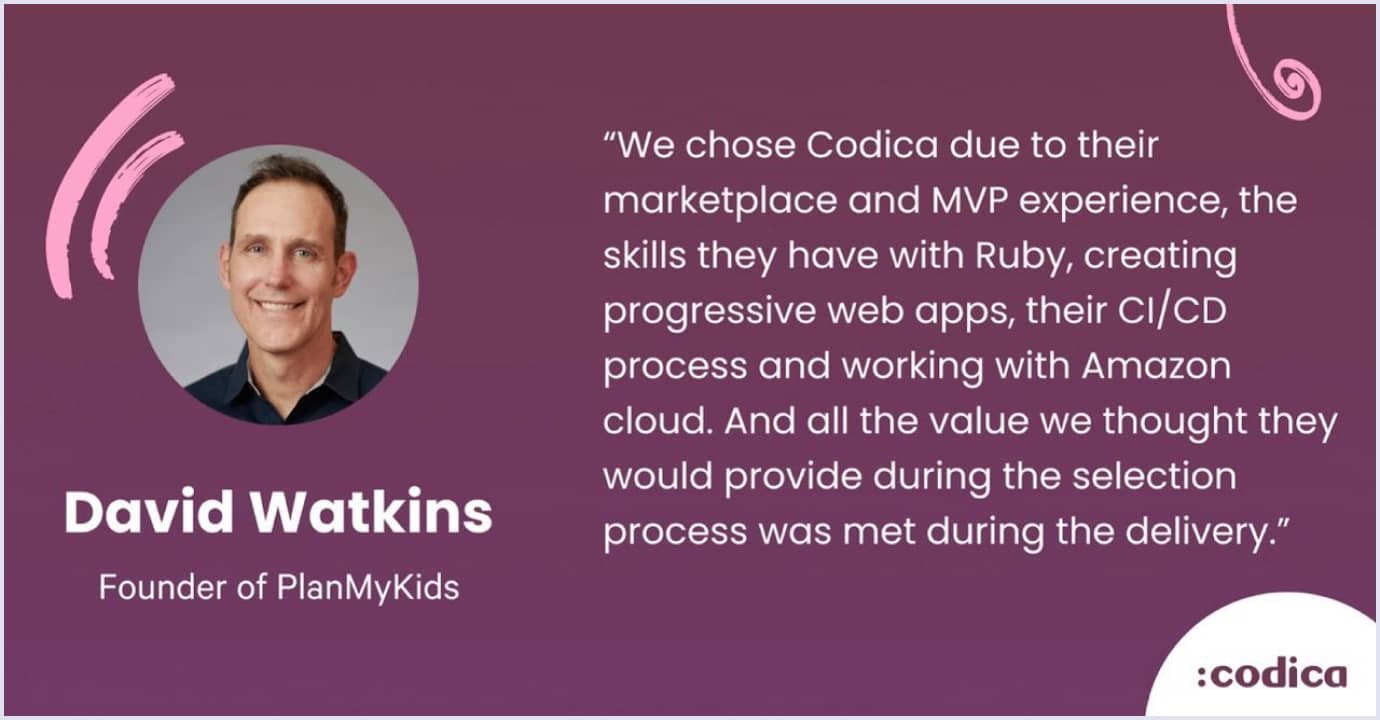
Step 4: Quality assurance to ensure proper work
This testing phase ensures that your marketplace software will be successfully launched and work. Thanks to the testing strategy, our QA engineers receive clear guidelines on what must be checked and how the final product should function. Moreover, we create acceptance criteria that show when the tests are passed, ensuring the proper work of your website.
Thanks to automated tests of performance and compatibility for components, we can thoroughly check the entire solution when we craft websites like Etsy. Thus, your sellers and buyers gain a top-notch marketplace that they enjoy.
Step 5: Maintenance and support to keep your marketplace up and running
Once your peer-to-peer marketplace is in use, our support does not stop here. We continue to monitor your solution to ensure its security. Also, whenever you need an update or launch a new feature, our team is happy to assist you with this. Thanks to the best practices in DevOps services, maintaining and supporting your marketplace ensures security for potential customers, which in turn fosters trust among your customers.

Estimating the cost of developing a website similar to Etsy
Now, we have come to an interesting question about the cost of Etsy's website.
To put it short, the main aspects that have an impact on the final price are:
- The development approach: out-of-the-box solution vs. custom web development;
- The required functionality you want to implement.
Obviously, the ready solution costs less than custom development. However, for complex projects like building Etsy’s clone, we recommend you choose an experienced agency and build a custom website.
Below, you can see a table that shows the rough estimate of the total cost to build a marketplace like Etsy. To receive the final prices, we used the average rate of Eastern European development agencies, which is $50 per hour.
| Cost of MVP development for marketplaces similar to Etsy | ||
| Features | Time, hours | Cost ($50/h) |
| Design | ||
| UX development | 56 | $2,800 |
| UI development | 96 | $4,800 |
| Architecture | ||
| Project setup | 36 | $1,800 |
| DB structure | 24 | $1,200 |
| Integrations | ||
| Payment (Stripe or PayPal) | 80 | $4,000 |
| Shipment (Shippo) | 80 | $4,000 |
| Main functionality | ||
| Authorization and security | 56 | $2,800 |
| User profiles | 32 | $1,600 |
| Homepage | 64 | $3,200 |
| Search and filters | 72 | $3,600 |
| Product page | 32 | $1,600 |
| Reviews and ratings | 48 | $2,400 |
| Shopping cart | 84 | $4,200 |
| Vendor panel | 92 | $4,600 |
| Admin panel | 72 | $3,600 |
| Non-development activity | ||
| Project management | 72 | $3,600 |
| Quality assurance | 92 | $4,600 |
| Code review | 36 | $1,800 |
| Total | 1124 | $56,200 |
So, how much does it cost to create a website like Etsy? The approximate estimate is $56,200. Please consider that the final price will depend on your web development partner.
Undoubtedly, the creators of Etsy invested significant costs in their web development. So, it is essential to understand that building a marketplace like Etsy will not cost a small amount.
Related reading: How Much Does It Cost to Build a Website in 2025?
Codica’s role in delivering your Etsy-inspired marketplace
Since 2015, the Codica team has been delivering high-quality and robust ecommerce solutions in different domains. In particular, we will help you build an online marketplace like Etsy. Over the years, we have successfully launched many ecommerce platforms that help our customers grow their online marketplace business, receive high traffic, and increase sales.
What truly sets us apart is our ability to tailor solutions that are functional and aligned with your marketplace's unique needs. Your business project will benefit from our skills in delivering user-centric, aesthetically appealing solutions and equipped with the latest technology trends. Our team understands the difficulties of creating a marketplace that stands out in a crowded digital landscape, and we are ready to guide you through this development journey.
The foundation of any booming marketplace lies in a well-thought-out strategy, robust architecture, and an intuitive user experience. We don't just build platforms; we co-create success stories with our clients, understanding their vision and translating it into a digital reality.
We are committed to delivering a project and fostering a growth and transformation partnership. Your marketplace journey will be marked by our unwavering support and a team that genuinely invests in your success.
Let's check some of the successful projects our specialists have delivered.
Custom ecommerce solution
This project is a multi-vendor marketplace platform with no analogs in the UK or Europe. It provides many options to users, allowing them to offer products and services within one platform between its B2C (business-to-consumer) and C2C (consumer-to-consumer) parts.
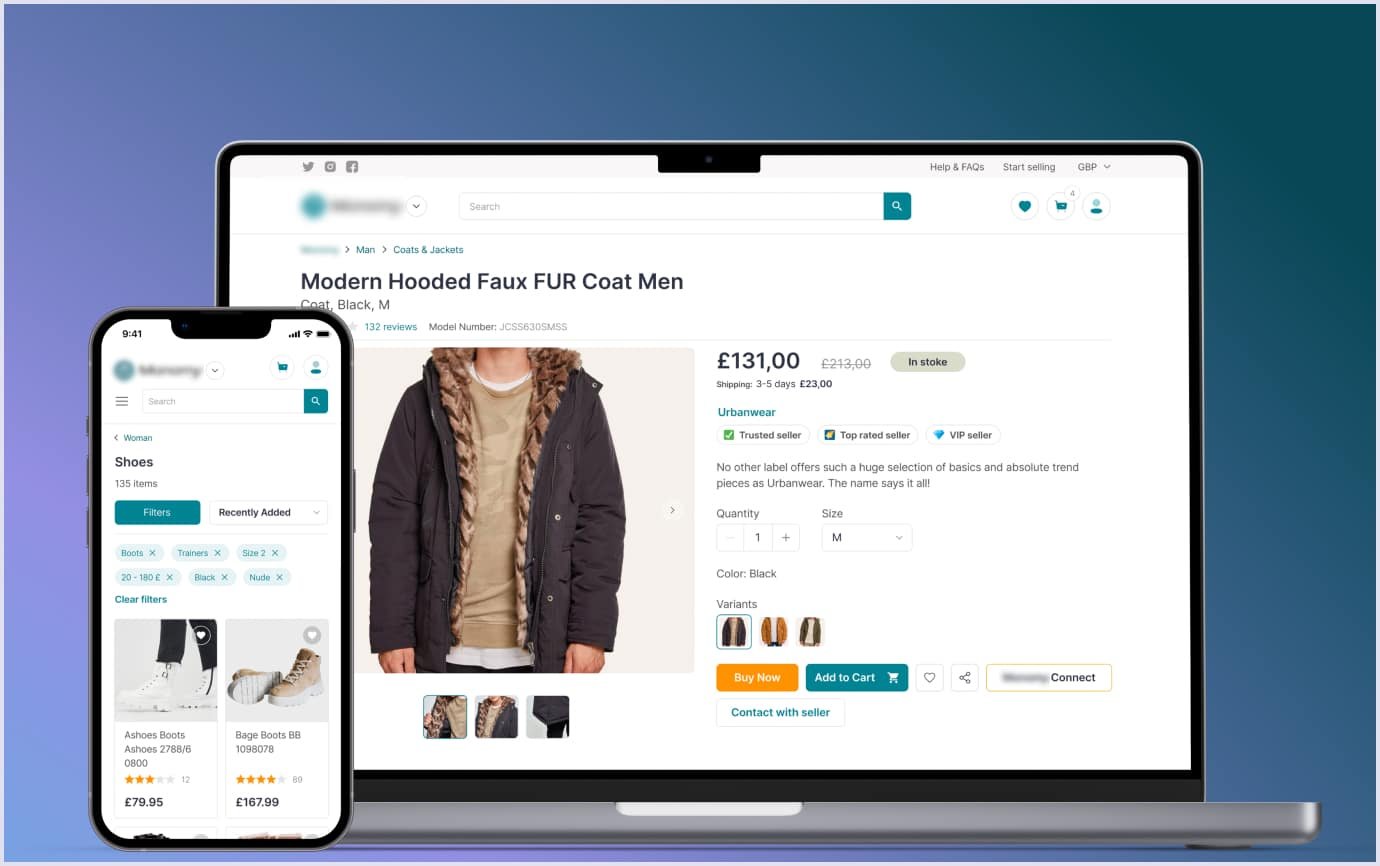
Here are some of the results of our collaboration with this big client:
- Checked the marketplace business idea with real users with the help of an MVP platform and improved the custom ecommerce solution based on the collected data.
- Developed the appealing design of a custom ecommerce solution that is inviting, eye-pleasing, and intuitive.
- Performed competent SEO of the marketplace to make the custom multi-vendor website receive more visitors.
- Provided an option for users to find services by choosing a location radius owing to the geolocation and map integration.
Also, we offer you another vivid example of an online marketplace we have developed.
Online marketplace for boats in Australia
Trade A Boat is Australia's favorite online platform to sell and buy new/used boats and marine equipment. Our customer's main request was to refine the existing solution and create a new website to reach better business results. The main requirement was also to make this popular boat-selling website in Australia mobile-friendly and fresh-looking.
There is the result of our collaboration with the client:
- Delivered a progressive web application, which provides an improved user experience.
- Conducted complex SEO to make the website noticeable on the web and user-friendly.
- Integrated third-party services that allow receiving advertisements from dealers throughout Australia.
- Created user-friendly interface - updated product card, added category icons to increase readability, highlight important content, and improve UX design.
Thus, our expert team worked thoroughly to implement all the required functionality for these ecommerce marketplaces. As a result, our clients got a fast-loading, fully functional platform with a smooth UX and advanced search filters, thanks to our:
- Product discovery services;
- UI/UX design services;
- Ecommerce marketplace development services;
- DevOps services;
- Quality assurance services.
We are always glad to share our stories of successful marketplaces with our readers. Find a minute to look at our portfolio. Each project in our portfolio is a testament to our commitment to excellence, innovation, and a client-centric approach.
Read also: 14 Top Ways to Attract Sellers and Buyers to Your P2P Marketplace
Final thoughts
A website like Etsy is an exciting experience that requires careful planning, dedication, and a commitment to fostering a vibrant online marketplace. This step-by-step guide on how to create a website like Etsy has illustrated the process's key considerations and essential phases, from ideation to launch.
So, we have discussed all the points you should consider before building a platform like Etsy. We got acquainted with Etsy's success story and discovered this marketplace business model and monetization strategies. Moreover, you get a picture of how to create a site like Etsy. Now, you have this essential information to help you launch a booming P2P marketplace.
If you are wondering how to create a website like Etsy but don't know where to start, our full-cycle software development team will gladly assist. Contact us, and we will create a high-quality, user-friendly, and thriving ecommerce marketplace for you.

